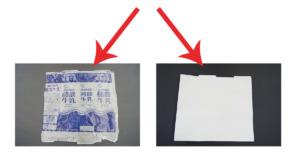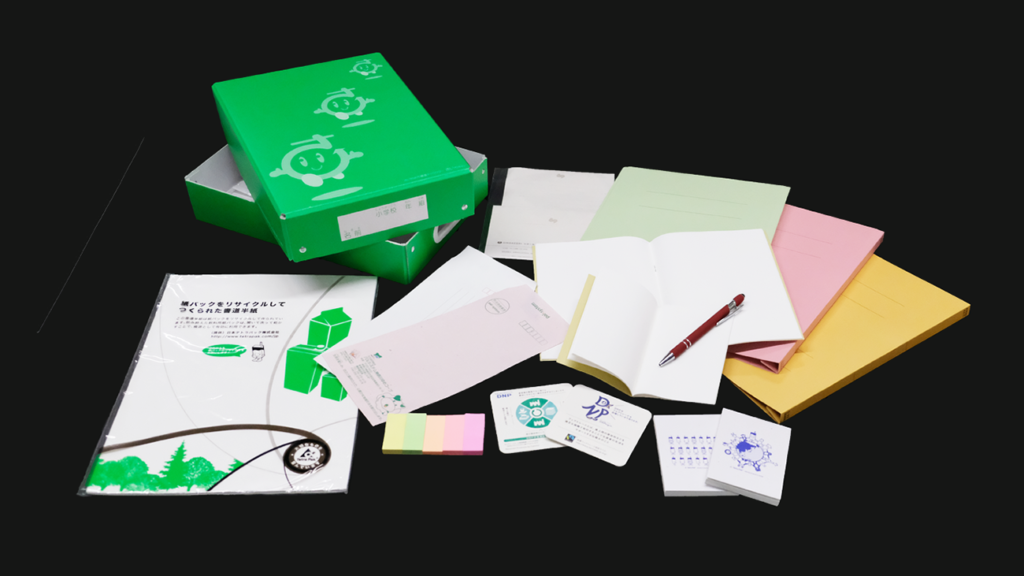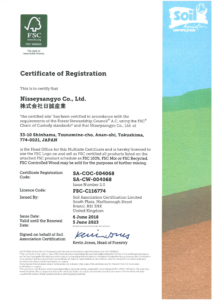
What makes our recycled pulp so special?

What makes our recycled pulp so special?
While most recycled pulps are manufactured using various types of paper waste such as newspaper and magazines which require de-inking process, our recycled pulp is made only from the finest raw materials such as milk cartons or laminated paper that do not require de-inking. It is this strict selection of raw materials that allows us to manufacture recycled pulp that are of similar quality as virgin pulp.
Why can cartons create high quality recycled pulp?

Paper carton (laminated waste paper)
Cartons for milk and other beverages are laminated with polyethylene film and printing is done on the polyethylene film instead of the paper itself. Therefore, by separating the film with print ink makes it possible to extract the clean pulp easily without relying on the de-inking facility.
Why can cartons create high quality recycled pulp?

Paper carton (laminated waste paper)

「Film」 「Pulp」
Cartons for milk and other beverages are laminated with polyethylene film and printing is done on the polyethylene film instead of the paper itself. Therefore, by separating the film with print ink makes it possible to extract the clean pulp easily without relying on the de-inking facility.

「Film」

「Pulp」
Recycled Pulp Specifications
Recycled Pulp Specifications
Items |
||
Whiteness |
30~90 % |
Level of whiteness |
Filterability |
300~600 ml |
Fiber Length (Long or short) |
Tensil strength |
2~5 km |
Strength towards pulling |
Burst factor |
2~3 kPa・m²/g |
Strength towards vertical pressure |
Tear strength |
6~16 mN・m²/g |
Strength towards tearing |
The strength vary depending on the bend of various types of paper.
Items |
||
Whiteness |
30~90 % |
Level of whiteness |
Filterability |
300~600 ml |
Fiber Length (Long or short) |
Tensil strength |
2~5 km |
Strength towards pulling |
Burst factor |
2~3 kPa・m²/g |
Strength towards vertical pressure |
Tear strength |
6~16 mN・m²/g |
Strength towards tearing |
The strength vary depending on the bend of various types of paper.
Packaging Examples

Packaging example for
international shipping

Packaging examples for
domestic shipping

Packaging example for international shipping
| Measurements | 1,200×800×1300mm |
| Wet Weight | 920kg |
| Dry Weight | 440kg |

Packaging examples for domestic shipping
| Measurements | 1,200×800×1700mm |
| Wet Weight | 1260kg |
| Dry Weight | 600kg |
Measurements |
1,200×800×1300mm |
1,200×800×1700mm |
Wet Weight |
920kg |
1260kg |
Dry Weight |
440kg |
600kg |
Please contact us for the details of the specifications and packaging.
Please contact us for the details of the specifications and packaging.
Overseas Transactions

Nissey Sangyo has obtained FSC®-CoC Certification on June 6, 2013. We are proud to announce that our recycled products should meet the sustainability requirements of top global companies.
The pulp used in cartons contain a large amount of softwood pulp (N or Nadelbäume pulp) made from coniferous trees as opposed to a hardwood pulp (L or Laubholz pulp) made from broad-leaved trees and can provide reliable strength.
Overseas Transactions

Nissey Sangyo has obtained FSC®-CoC Certification on June 6, 2013. We are proud to announce that our recycled products should meet the sustainability requirements of top global companies.
The pulp used in cartons contain a large amount of softwood pulp (N or Nadelbäume pulp) made from coniferous trees as opposed to a hardwood pulp (L or Laubholz pulp) made from broad-leaved trees and can provide reliable strength.
About FSC
The pulp is used in a variety of materials in our daily lives. As the technology advanced, its use has expanded considerably from the raw material for paper to building materials and packing materials to clothing. Its consumption soared and created an issue of deforestation.
Nissey Sangyo has contributed to the preservation of forests by recycling a pulp from high quality paper instead of sourcing wood pulp. In order to further contribute to the protection of forests and providing our clients with more sustainable alternative, we obtained this FSC certification.
Certification Number: SA-COC-004068
What is FSC (Forest Stewardship Council®)?
The Forest Stewardship Council (FSC) is an international non-profit, multi-stakeholder organization established in 1993 that claims to promote responsible management of the world’s forests. It’s made up of representatives of environmental organizations, forest and lumber traders and indigenous groups. Its headquarters is located in Bonn, Germany.
■Forest Management Certification
FSC offers two main types of certification: “FM Certification: Forest management” and “CoC Certificatation: Chain of custody. Nissey Sangyo has obtained “CoC Certification”.
About FSC
The pulp is used in a variety of materials in our daily lives. As the technology advanced, its use has expanded considerably from the raw material for paper to building materials and packing materials to clothing. Its consumption soared and created an issue of deforestation.
Nissey Sangyo has contributed to the preservation of forests by recycling a pulp from high quality paper instead of sourcing wood pulp. In order to further contribute to the protection of forests and providing our clients with more sustainable alternative, we obtained this FSC certification.
Certification Number: SA-COC-004068
What is FSC (Forest Stewardship Council®)?
The Forest Stewardship Council (FSC) is an international non-profit, multi-stakeholder organization established in 1993 that claims to promote responsible management of the world’s forests. It’s made up of representatives of environmental organizations, forest and lumber traders and indigenous groups. Its headquarters is located in Bonn, Germany.
■Forest Management Certification
FSC offers two main types of certification: “FM Certification: Forest management” and “CoC Certificatation: Chain of custody. Nissey Sangyo has obtained “CoC Certification”.
Use of Recycled Pulp
We manufacture tailor-made recycled pulp required for variety of purposes by blending carefully selected used paper.
① Western-style paper
① Western-style paper
Recycled pulp with high whiteness and very little dirt is ideal for Western-style paper.

Notebooks, tags and labels and paper binder,
diaries, Japanese writing paper,
traditional paper, paper bags
Use of Recycled Pulp
We manufacture tailor-made recycled pulp required for variety of purposes by blending carefully selected used paper.
① Western-style paper
① Western-style paper
Recycled pulp with high whiteness and very little dirt is ideal for Western-style paper.

Notebooks, tags and labels and paper binder,
diaries, Japanese writing paper,
traditional paper, paper bags
② Household paper
② Household paper
Cartons are made from coniferous trees characterized by its strengths. Their recycled pulp is widely used for household paper products.
Facial tissue,
Toilet rolls, kitchen paper,
Towel paper, paper napkins, paper cups,
wet tissues, paper twine

② Household paper
② Household paper
Cartons are made from coniferous trees characterized by its strengths. Their recycled pulp is widely used for household paper products.

Facial tissue,
Toilet rolls, kitchen paper,
Towel paper, paper napkins, paper cups,
wet tissues, paper twine
③ Other uses
③ Other uses
Recycled pulp are also used for a variety of non-paper products due to its unique characteristics. For example, it’s used as an alternative to asbestos for more than 20 years.

Building materials (exterior and interior),
Mold products, masking tapes,
Resin Compound, Dog sanitary sheets
③ Other uses
③ Other uses
Recycled pulp are also used for a variety of non-paper products due to its unique characteristics. For example, it’s used as an alternative to asbestos for more than 20 years.

Building materials (exterior and interior),
Mold products, masking tapes,
Resin Compound, Dog sanitary sheets
Environmental Marks





Environmental Marks






